Narrelle M. Harris's Blog, page 20
June 17, 2019
U.S.-only Grounded Special Offer to 1 July
Grounded is one of the best paranormal romances I’ve read
~ Elizabeth Fitzgerald, Goodreads.

~ D. Antonio (Amazon)
All this week and next, from 17 June to 1 July 2019, US-based retailers are having a price promo on my spec-fic winged romance, Grounded!
That’s right: if you’re in the USA, you can pick up Grounded (only available in ebook format) for 99c!
The blurb:
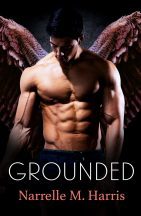
In a world where wings give everyone the freedom to fly, an artist born wingless uses her art to show the winged world the wonder of the ground. But when she meets a recently injured police officer who finds himself grounded, they will both learn that there is more than one way to soar.
Read more about Grounded.
The world held me captive and I would love to read more within it!
~ Deborah, Goodreads
The participating US companies that I know of include iTunes, Amazon US, Kobo and Google Play, but other US-based retailers may also be taking part. Let me know in the comments if you find another!
NOTE: The offer is only available in US stores (so if you’re not in the US, geo-blocking may prevent you from accessing the deal).
…romance a beat away from the norm.
~ Kelsie, Goodreads
June 13, 2019
New life for ‘Nil By Mouth’ and ‘The Fear Collectors’.
Shooting Star Press is bringing back to the Australian genre scene some very bright stars that paradoxically contain some very dark matter – as you can tell from these magnificently unsettling covers.
I was delighted and honoured when publisher Cath Brinkley asked me to introduce two of their newly republished works at their Continuum 15 launch in June 2019.
Nil by Mouth by LynC
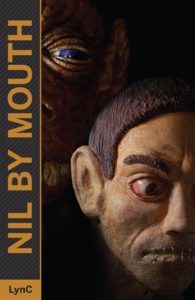
I first read Nil By Mouth in 2014 and was profoundly captured by the story of Ale, a human being who undergoes many emotional and physical transformations in the course of an alien invasion.
Nil By Mouth is many things: deeply horrific and deeply humane; filled with thoughtless cruelty and mindful compassion. It’s unexpected and unpredictable and entirely marvellous. I’m so pleased that Shooting Star Press is bringing this impressive work back into print.
And as unsettling as the cover is on first glance, I’m growing to love it more and more. What we think we see at first isn’t actually what’s happening.
What seems on the surface monstrous is something else: from the blue alien eye that, with time, appears to be gazing on Ale with compassion; and Ale’s rock-bottom despair is on the verge of the what-comes-next, the hope that’s about to bring him from the abyss. (Of course, I have the benefit of hindsight – I’ve read the book!). Lewis Morley has been as extraordinary with this cover as LynC as been with its contents!
Buy Nil By Mouth
Nil By Mouth (Amazon Kindle) Nil By Mouth (Amazon Paperback) Nil By Mouth (Shooting Star) Nil By Mouth (Kobo) Nil By Mouth (Barnes and Noble) Nil By Mouth (Booktopia)
The Fear Collectors by Lauren E Mitchell

Do you know
that feeling in dreams that begin to morph from thing to another and it makes
sense because that’s just how it is in dreams?
That’s sort of The Fear Collectors, which is adventure/horror meets YA meets surreal science fiction meets hello-I-wasn’t-expecting-that-to-happen. Or that. That either.
It’s like how dreams start so simply and non-threatening sometimes and proceeds to take weird left turn after turn until you don’t know what’s what.
One minute you’re bicycling down a hill in your pyjamas and then suddenly you’re wearing a backpack full of hardcover books but no they’re moving (and are rats now) and you’ve cycled off a cliff and if you pedal fast enough you’ll keep in the air and then you’re at a picnic (the bikes are leaning against the stone wall) and everyone has baguettes and you hear music and get up and can’t find how to turn the music off so it doesn’t wake up everybody else (and you don’t want to even think about who all those everybody elses are) and then you actually wake up and you’re still in bed and everything feels bent out of shape even though you know you were only dreaming, or at least you think you were, and you’re not still dreaming, and you *are* awake now, aren’t you?
The Fear Collectors zings through its paces like that, from placid to terrifying; from youthful adventure to nightmare fuel; and dark horror to SF, all the way to the end.
Buy The Fear Collectors
The Fear Collectors [image error] (Amazon US)
The Fear Collectors (Shooting Star)
The Fear Collectors (Kobo)
The Fear Collectors (Barnes and Noble)
The Fear Collectors (Booktopia)
June 3, 2019
Cover Reveal: Kitty and Cadaver
Kitty and Cadaver is being launched this weekend at Continuum – and here I’d like you all to see the gorgeous cover designed by Willsin Rowe (who has done so many fantastic covers for me!)
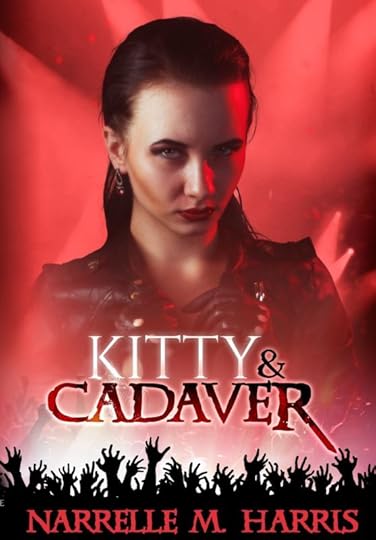
If you’re unable to attend Continuum for the launch, never fear – I’ll be holding a public launch in July at a Melbourne venue where Jess Harris and her band will perform some of the songs from the book!
May 30, 2019
Australian Music: 2014
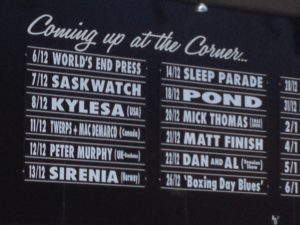 Richmond’s Corner Hotel
Richmond’s Corner HotelOver on my Patreon, I’ve started posting cahpters for the fourth Duo Ex Machina book, set in 2014.
Kiss and Cry brings Frank and Milo five years on from the events of Number One Fan: Frank is a successful producer and Milo is concentrating on raising funds and doing work with his Foundation. I’m inventing lyrics and bands for the story, but the real music scene was full of amazing real Australian musicians.
Melbourne live music was also changing in 2014. Music venues had been facing difficulties with restrictive regulations on things like liquor licensing, noise level complaints from new residents in areas where venues had been for decades (we nearly lost Cherry Bar), and conditions for all-ages concerts – then in March 2014, the Victorian government introduced reforms to ensure the city’s incredible music scene not only survived but continued to thrive.
Just as well, not only for Australian cultural life, but for the music sector’s contribution to the economy (valued at over a billion dollars in 2013).
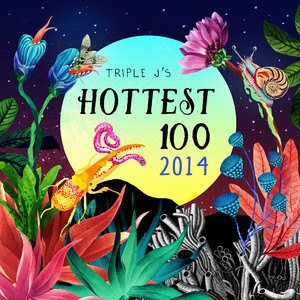
Actually, a report by Pollstar had revealed Melbourne venues were among the top in Australia: from Richmond’s Corner Hotel as the top Australian spot and 13th worldwide. (In fact, the Corner makes an appearance in my upcoming novel, Kitty and Cadaver.)
In 2014, Sia, Iggy Azalea and 5 Seconds of Summer were all charting in the UK and US while the JJJ Top 100 2014 was full of Chet Faker, the Hilltop Hoods, Lorde, Chvrches and Vance Joy and contained the since-ubiquitous Uptown Funk.
(While we’re here, this is one of my favourite videos using Uptown Funk.)
Here in 2019, some of the venues that were under threat 5-10 years ago are still going strong: Cherry Bar, the Tote and The Espy, which has just undergone a massive refurbishment and still has three stages and some impressive cocktail bars as well as free local music in the basement.
But back in 2014 Melbourne, Frank and Milo and their friends and family will continue to listen to the Hilltop Hoods’ Cosby Sweater and Sia’s Chandelier and donate to the soundproofing of venerable venues to save them for the future.
Check out the first three novellas in the Duo Ex Machina series!

May 29, 2019
Cover Reveal: War of the Worlds – Battleground Australia

I am absolutely thrilled to be able to share with you the cover for the upcoming anthology, War of the Worlds: Battleground Australia, featuring sixteen stories by some fantastic Australian and New Zealand SF, crime and spec-fic writers!
Battleground Australia was conceived and edited by Horror Australis – the collective moniker for Steve Proposch, Christopher Sequeira and Bryce Stevens – and explores how the Martian invasion first imagined by HG Wells affected the other side of the world!
Movie director Alex Proyas (The Crow, I Robot, Gods of Egypt) has written and introduction and the stories are illustrated by Jan Scherpenhuizen and Sholto Turner.
War of the Worlds: Battleground Australia will be released in hard cover, paperback and eBook.
The stories, set in Australia of the past, present and future, are by Kerry Greenwood, Carmel Bird, Jack Dann, Janeen Webb, Sean Williams, Angela Meyer, Lindy Cameron, Jenny Valentish, Narrelle M Harris, Lucy Sussex, Rick Kennett, Jason Franks, Dmetri Kakmi, Bill Congreve, Jason Fischer, and Kaaron Warren.
Continuum 15: soft launch
The book will be soft launched at Melbourne’s Continuum 15: Other Worldson Saturday June 8.
As this launch is open only to convention attendees, a public launch will be held at a later date. Stay tuned!
May 23, 2019
Review: The Definitive Albert J Sterne by Julie Bozza
 The Definitive Albert J Sterne
The Definitive Albert J Sterne This 2019 re-release of 2012’s The Definitive Albert J Sterne brings together the original novel along with the interweaving short stories previously published as Albert J Sterne: Future Bright, Past Imperfect. The result is over 220,000 words of crime thriller/complex love story. It’s a hefty book, but it’s dealing with some fairly hefty themes while still being an enthralling and gripping story.
The Definitive Albert J Sterne” rewards the time, though. Author Julie Bozza has crafted a book that is a slow burn and often difficult thriller which is threaded through with a slow burn and often difficult love story.
FBI forensic pathologist Albert J Sterne is a brusque
perfectionist, impatient with the folly of the world yet dedicated to using his
superb skills to solving crime. Intensely private and putting people offside
wherever he goes, few know of the childhood trauma that has led to so many
layers of walls between his actions and his feelings.
Sterne meets Special Agent Fletcher Ash in 1976 while
attending a crime scene that Ash discovered by chance while walking. Ash is
more charming than Sterne but he has his own awkwardness within the Bureau – an
ability to intuit things about cases which could leave him open to all kinds of
accusations and cynicism. Ash seems almost immune to Sterne’s brusqueness;
Sterne seems to find Ash less objectionable than other people.
Thus begins a friendship and FBI partnership that leads them
both onto the path of a serial killer. Over nine years, their friendship
evolves into a ‘friends with benefits’ and goes through many difficulties on
the way to a better understanding. They both have significant faults, but one
of the greatest barriers is Albert’s ruthless capacity for shoving his feelings
behind a fortress and pretending he doesn’t have them. He’ll give everything to
Ash through love, except any part of his true self.
Ash is hardly the model boyfriend either, and this story
primarily takes place in the 80s, when to be outed would be to lose their jobs.
Ash is also obsessed with the serial killer who leaves the brutalised bodies of
young men buried in the woods over several states. Frequently troubled and
frustrated, Ash also has some selfish tendencies when it comes to Albert.
And then there are the skin-crawlingly vivid chapters seen
through the eyes and the disturbing mind of the killer himself.
The reader knows early who is behind these deaths, but whodunnit is not the point. From start to finish, The Definitive Albert J Sterne is a psychological drama about love, trauma and death. It does go from dark into the light, but there is a lot of dark to work through first.
The writing is always clear and crisp, but the subject matter and Ash and Sterne’s never-easy relationship can be challenging as everything unfolds. I’ve said that it’s dark, and yet the core of it – Albert’s uneasiness about his love for Ash; Ash’s sometimes oblivious but ultimately utter conviction in his love for Albert – is a light of hope all the way through.
No solution comes in a hurry, but come it does, with great texture, compassion and deft understanding of human nature in a compelling thriller.
Content warning:
Because the story line deals with a serial killer, who gets his own chapters that give horrible but necessary insight into his state of mind, as well as descriptions of abuse, torture and violent crimes, Bozza has included a content warning in the book. This isn’t a light romance or cosy crime story – it’s gritty, often gruesome in its detail, and as excellent as it is, if the topics make you squeamish it doesn’t hurt to read that spoiler-free content warning in full.
Buy The Definitive Albert J Sterne
Universal Buy Link The Definitive Albert J Sterne Amazon US The Definitive Albert J Sterne Amazon UK The Definitive Albert J Sterne Amazon AU The Definitive Albert J Sterne Amazon DE The Definitive Albert J Sterne Smashwords The Definitive Albert J Sterne Barnes & Noble The Definitive Albert J Sterne Kobo The Definitive Albert J Sterne Google PlayThe Definitive Albert J Sterne iTunes US
May 16, 2019
My Library: Such is Life by Joseph Furphy
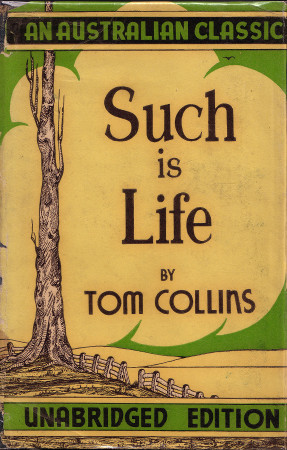
In my research about Victorian-era society in the UK and Australia, I sometimes pick up 19th century fiction. Such Is Life – an Australian classic, I’m told – is set in the 1880s, was written in 1897 and not published till 1903. The title comes from what were reputedly Ned Kelly’s last words before he was hanged in 1880, and the phrase pops up periodically as an ironic literary shrug about the whims of fate.
Such is Life is a series of anecdotes about the people government worker Tom Collins meets in his travels in rural Australia. That makes it sound straightforward, which is certainly isn’t, as the novel is punctuated with long and rambling side stories. A tale may start with a campfire story, diverge onto discussions of other, slightly related stories, philosophical tracts and adept interpretations of Shakespeare, before finally meandering back to the original point. The style makes it challenging to read but provides a lot of its charm too.
The narrator, Tom Collins (his name itself a 19th century term for a tall story) spends time with bullock drivers, boundary riders, itinerant workers, graziers and the like. There’s lots of swearing but it’s all signified by terms like “What the (sheol)” (hell) and phrases like “good (ensanguined) shot!” and “poor (fellow)”. I no doubt substituted even fruitier language than he intended while reading, and the use of the substituted terms could be coy but is often very funny in its context.
Some stories are full of humour – like the one where Tom loses all his clothes in the river and his skulking about naked, trying to resolve the issue without scandalising anyone. (The repercussions of this misadventure are discovered some chapters later.) Others are full of the sad, grim reality of bush life with the campfire stories of children lost in the wilderness, some discovered too late or not at all.
(Frederick McCubbin produced several paintings about this deep anxiety for white settlers in this country.)
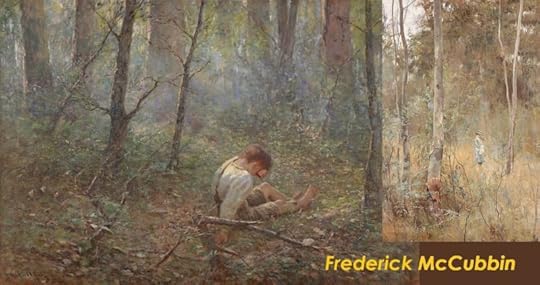
But there’s more to Such is Life than a relatively realistic though rambunctious look at rural life in Australia at the time.
In my 19th century research, I’m looking for hints and examples of queer life, representation and perception, since contemporaneous accounts keep queerness hidden or coded when it’s not being excoriated. So colour me pleasantly surprised when I discovered that Such is Life is open to queer interpretation in no uncertain terms.
In the first chapter, two men with the bullock teams are noted as disappearing in the night for an unknown reason – Dixon and a fellow called Bummer (the colloquial term for a loafer or layabout). Nothing is explicit, but you can’t convince me that 19th century readers weren’t fully alive to a filthy pun when they read it.
More frequent is a playful and curious sense of gender switching that permeates the story. Tom’s horse Cleopatra is actually a stallion; in the naked escapade, he’s hiding at a farm and hears someone call for ‘Jim’ who turns out to be a young woman named Jemima. Clearest of all is the long sequence where Tom is talking to the disfigured misanthrope, Nosey Alf, and it’s clear to the reader (if not to Tom) that Alf is a woman. Because of previous chapters we can discern who Alf Jones really is and perhaps interpret their reasons for living in men’s clothes, but Tom’s obliviousness means we’ll never fully learn Nosey Alf’s own reasons (or what pronouns are most appropriate).
Such is Life can be hard work to read because of all these lengthy off-piste passages, as well as some pretty convoluted writing. The book is full of difficult to follow dialogue written phonemically, reflecting the multicultural nature of the life. I’d feel the dialect of the Chinese boundary rider’s English was a lot more racist if it weren’t for the fact that Furphy gives exactly the same treatment to the Dutch, Irish, Scottish and even posh English characters throughout.
A book of its time, Such is Life has the expected baseline sexism and racism – yet there’s an egalitarian streak that runs through it, noting at one point: “Better no religion at all – if such lack be possible – than one which concedes equal rights beyond the grave, and denies them here”. In between rough bush talk and rougher bush lives, Tom frequently philosophises on deep questions, including the nature of free will (referencing Hamlet and Macbeth) and notions of love.
For anyone wanting social insight into 19th century rural Australia and to explore some attitudes to queerness, Such is Life is worth a look. It might be best to read it in small bites however, to better digest the strange divergences, dense colloquialisms and long literary discourses
Telling a furphy
As a curious aside, Australian vernacular has a term – a furphy – to refer to a rumour or a false story. You’d think it derived from Joseph’s book but in fact the etymology experts note that it comes from the water carts belonging to Joseph’s brother John: people would gather round John’s water carts for ablutions and gossip, and thus the term gained use.
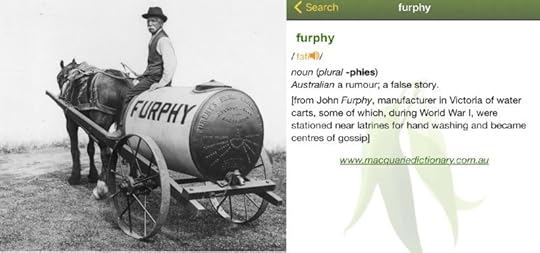
Further reading
Damien Barlow explores the queerness of the book in Un/making Sexuality: Such is Life and the Observant Queer Reader (Australian Literary Studies; Volume 21, Issue 2, October 2003)On the 100th anniversary of the book, The Age newspaper also wrote about it.The Furphy company still exists!
May 9, 2019
My Library: Victorian Ladies at Work by Lee Holcombe
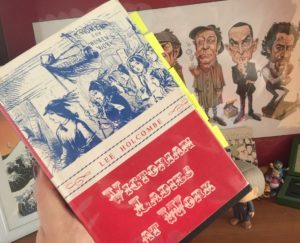
I can never pass a second-hand
bookshop without at least browsing to see what they might have on 19th century
social history, and on a recent rural sojourn, I spotted Victorian Ladies at
Work by Lee Holcombe.
From a quick glance, I’d expected
(and admittedly wanted) a rich history of the working lives of women from the
poorest to the highest, with illustrative examples from the papers of the time
or Henry Mayhew’s London Labour and the London Poor.
That is not this book. Instead, Victorian
Ladies at Work is a detailed look at 19th century feminism and the movement
for middle class women to find their place in the workforce. Their working
class sisters had been toiling away for a long time, but if a woman had the
misfortune to be middle class but suddenly poor, she had few skills to fall
back on to earn money and survive.
Despite women’s often limited
education – their future security was meant to rely on marriage alone – many
had to find work as governesses, a vaguely respectable way to keep from the
last resort of prostitution. The work was inconsistently and poorly paid – no
wonder Violet Hunter was so excited at the prospect at going from £4 a month to
£100 a year for the trifling inconvenience of wearing an electric blue dress
and cutting her hair off in the Holmes tale, “The Copper Beeches”.
Victorian Ladies at Work goes on to explore the drivers
of change in elementary and secondary education for girls and women in the late
Victorian era (making them fitter to teach), the institutions established to
argue for women’s right to work and all the difficulties on the way – some of
which clung to women in the workforce well into the 20th century and even
persist in some forms today, most particularly unequal pay.
Holcombe looks at the specific
histories of roles for middle class women in employment and their development
as professions: governessing and teaching; nursing; shopgirls; clerical roles
and the civil service.
 See all my sticky notes!
See all my sticky notes!Florence Nightingale gets her
usual spotlight for helping to turn nursing into a respectable profession for
women (rather than a refuge for drink-riven ‘gamps’, named for an incompetent
Dickensian nurse). The plight of shopgirls’ dreadful accommodation and pay is
examined alongside the growing trade union movement for fair pay and better
conditions.
The Victorian era introduced the
notion that single women might hold positions – and were often preferred
because they’d often do the same work as a man (and were often thought to be
more stable and therefore better than young men at some work) but for less pay.
At the same time, the moment that single woman married she lost her job,
because her security was now supposed to derive from her husband.
I know this thinking was around
into the 20th century because my own mother, who was the in RAAF, had to resign
from the service as soon as she married my dad. I don’t think she personally
minded, but there must have been many women who did, and kept their marriages
secret for as long as possible.
 From Etsy
From EtsyThe absolute favourite thing I
learned, however, was the 1859 founding of the Society for Promoting the
Employment of Women.
That’s right – S.P.E.W.
I have to assume JK Rowling knew about them when she had Hermione establish the Society for the Promotion of Elfish Welfare in Harry Potter and the Goblet of Fire.
The real S.P.E.W. was led by
Barbara Leigh Smith, who also encouraged the English parliament to reform
women’s property law and presented petitions for women’s suffrage.
This wasn’t a cover-to-cover book
for me, but I’ll be dipping in and out of it when writing period stories to
reflect working conditions and pay rates. Anyone interested in 19th century
feminism and the development of the rights of working women might find it
useful
May 2, 2019
Research: Music Folklore and History
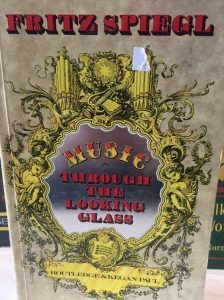
With Kitty and Cadaver book scheduled for a June release, I thought I’d share some of my reference books on music that I dip into for it. (And will continue to use for a sequel!)
Apart from the medieval research I did for “Hoorfrost” (which is in the Scar Tissue and Other Stories collection) and my reading on water-related British folklore (that’s for the as yet unwritten second K&C book), I need from time to time to refer to music-related folklore that I might adapt for the history of the band, as well as more practical references to musical instruments and trends throughout the ages.
Music Through the Looking Glass is a kind of modern lexicon – perhaps it can be seen as ‘folklore’ if you squint. It’s “a very personal dictionary of Musician’s jargon, shop-talk and nicknames, and a mine of information about musical curiosities, strange instruments, word origins, odd facts, orchestral players’ lore and wicked stories about the music profession’.
For example, there is a condition called “cellist’s nipple’ (cured through the use of a more padded bra) and “flautist’s chin” (an allergic reaction to the silver) and “fiddler’s neck”, which can look like a love bite.
Apparently “domino thumper” was a 19th century music hall slang term for a pianist and “licorice stick” was an American nickname for the clarinet.
The Larousse Encyclopedia of Music is a much more sensible book, and I got it so I could look at more historically accurate elements of music when I’m writing stories set during the band’s 700 year history. I haven’t had to use it much yet.
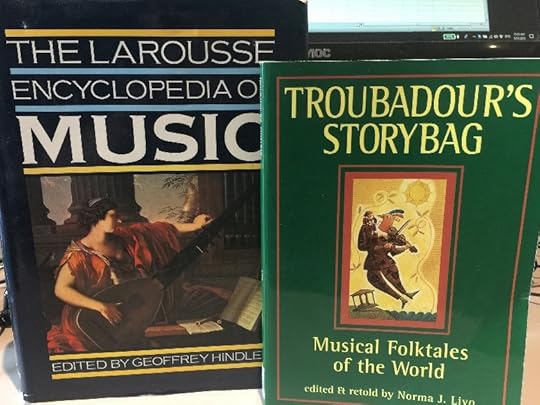
I’m more fond of Troubadour’s Storybag, as I’m looking for folk tales that I can adapt as having a “true story” involving a band with the magic gift of the Minstrel Tongue.
The stories retold come from all over the world – Nigeria, Greece, New Zealand, Japan, the US and Turkey, among others. The Dancing Shoes are there, and The Pied Piper, but also stories of singing bones, magic fiddles, nightingales and flutes.
All in all, I wish I’d had more call to dip into these research books. Perhaps I need to randomly select entries and use them as prompts for some short stories set in the Kitty and Cadaver universe.
Do you have any favourite musical folklore to share?
April 25, 2019
Research: Mapping the Past
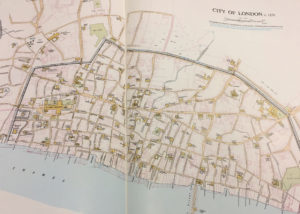 London, 1270
London, 1270While not always possible, it’s definitely good if a writer gets to tread the ground we write about. Some details, like the ambient sounds, the scents, the ineffable feel of a place, are best captured by experience, even to a small degree.
Some places exist primarily in the past, however, are beyond our reach to capture: at least until I get my own TARDIS.
Until then, the best tool at hand is access to old maps. They are excellent comparisons with the present, to see what still exists, and they are a window into places long past, yet which still lie just below the surface.
When I was writing “Hoorforst”, the Kitty and Cadaver origin story that appears in Scar Tissue and Other Stories, I needed to see what 13th century London looked like. Luckily, when I visited London earlier in 2018, the British Library came to my aid. (My Reading Room card is still my favourite souvenir of all my London visits!)
Medieval historian Christopher Brooke was my particular saviour on this point, providing a fantastic overview of the city’s culture and economy over several centuries. His work included pages of maps, showing change over time.
I used his map of London in 1270 (above) to chart William and Thomas’s progress through the old walls, across the frozen city to old London Bridge on the Thames. Some of the places on his map still exist today – St Paul’s and churches, mainly.
 Melbourne, 1852
Melbourne, 1852I have written various stories set in 19th century Melbourne as well. That city’s landscape changed a lot in a short time, thanks to the 1851 gold rush and the later economic crash of the 1890s.
The State Library of Victoria has a great map collection that assists with charting modern Melbourne against its history but one of the handiest I found when I was writing “Virgin Soil” for the And Then… anthology was this 1852 map showing the inner city layout and the streets just north of the city grid, along with a few of the major buildings of the time.
Let’s face it, old maps are fantastic in and of themselves, and I’d gaze on them avidly any day of the week. But they’re especially wonderful for helping to give shape to locations that remain only as ghosts under the skin of the present.



